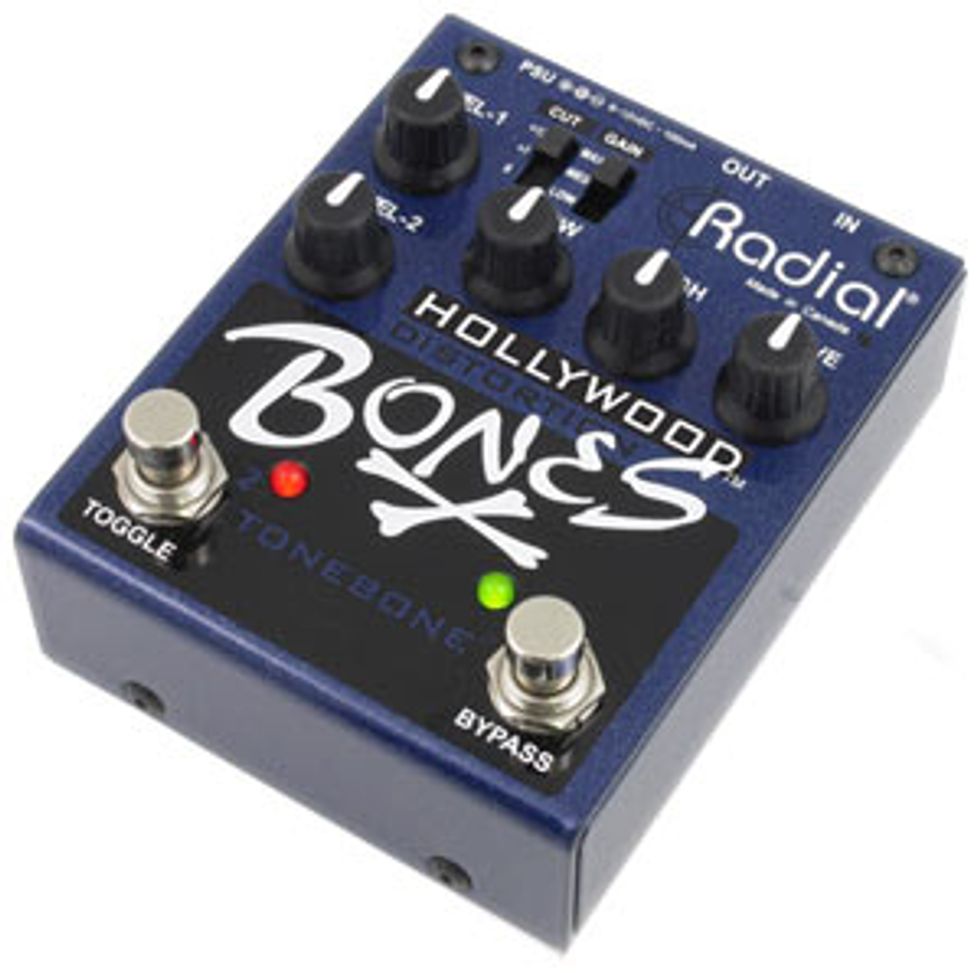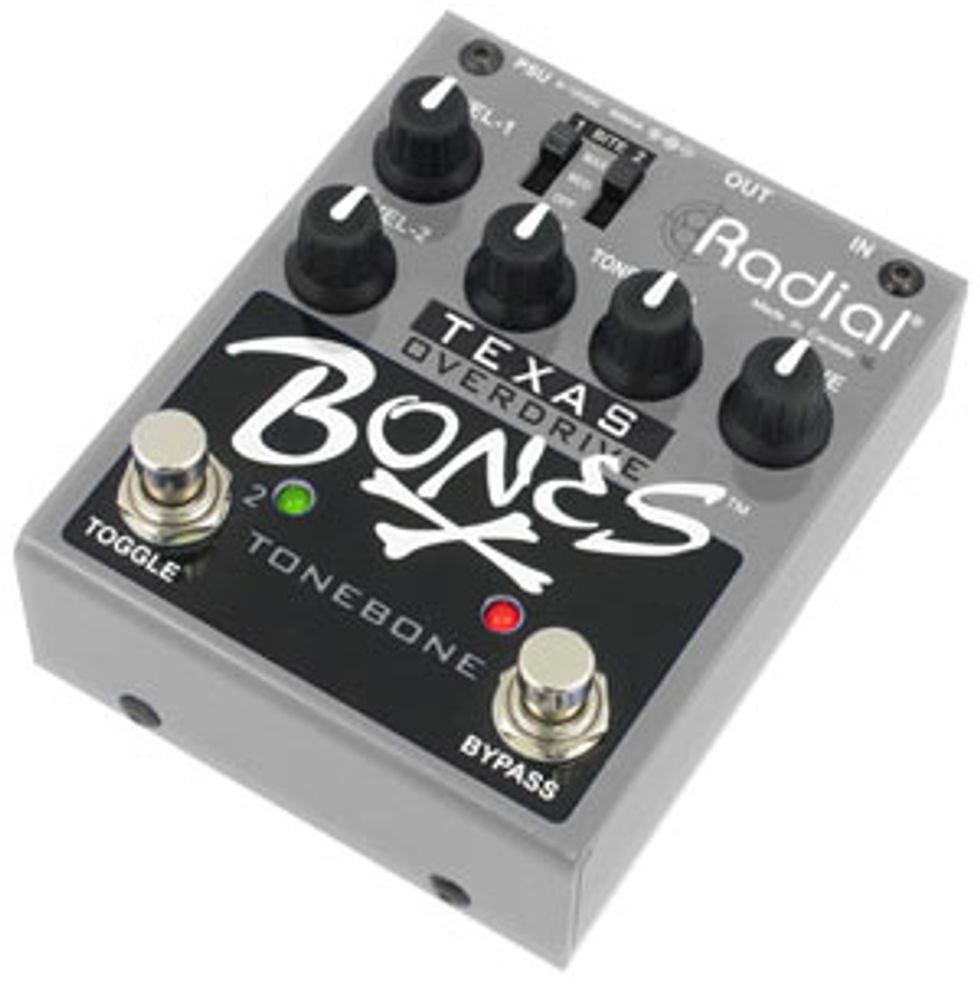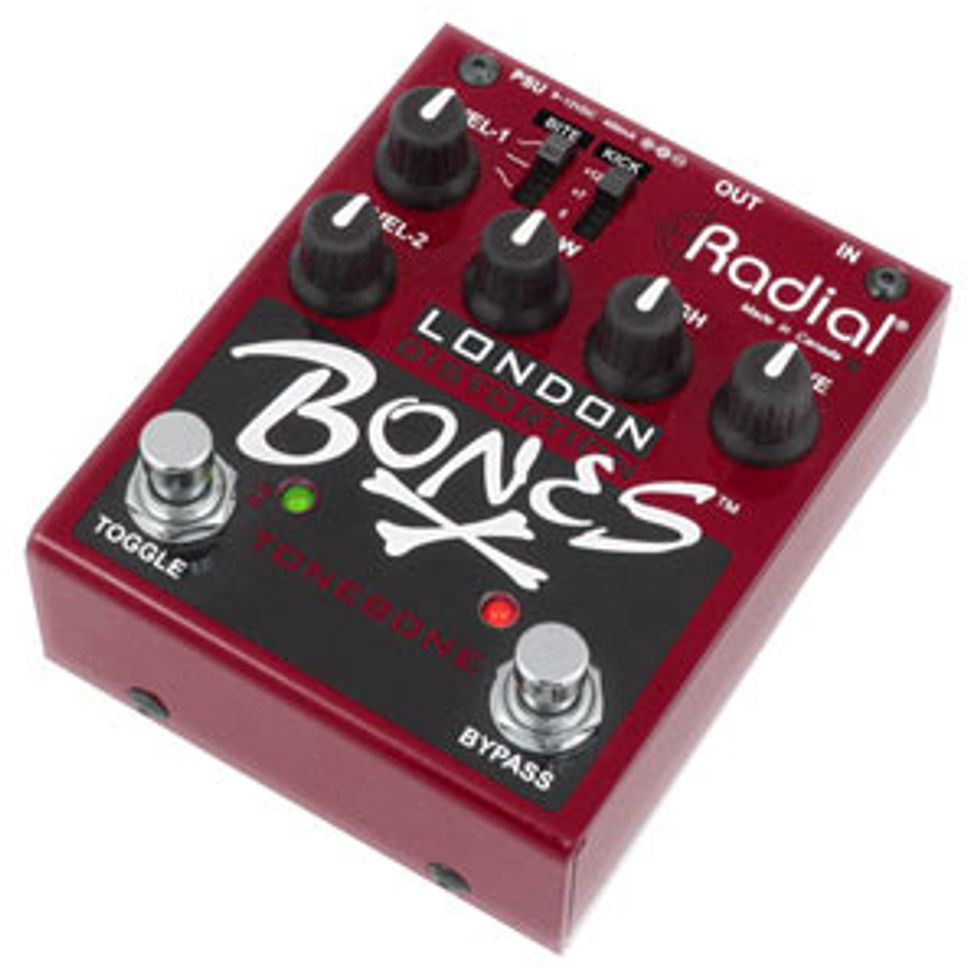Radial’s respected distortion pedals go small
Radial Engineering has been making their original Tonebone series of great sounding, tube-based distortions for quite a while now. Though they are well-respected in the guitar community for their wealth of utility items, such as amp and cabinet switchers, direct boxes, effects loop switchers, etc., they haven’t yet garnered the love afforded some of the other distortion pedal makers, whether mass-market or boutique.
There are several possible explanations: One possibility is that their mass-produced image has them being compared to much larger companies like Boss, Ibanez, and Digitech, making people miss the fact that the pedals are actually boutique quality. More likely, the plethora of controls on the Tonebone pedals cause guitarists to be stricken with option anxiety, while the unit’s large footprint, tube fragility, and specialized power needs have made them less welcome on many pedalboards than smaller, simpler, more bullet-proof pedals. Maybe Radial had similar thoughts, because their new Bones series of overdrives are tubeless; run on a standard Boss-style, 1 Spot, or Switchblade adapter; and take up less then half the space of the tube models.
The Hollywood Dual Distortion, Texas Dual Overdrive, London Dual Distortion pedals come in identical, solid, stamped-metal casings, and all share some design concepts. Each employs a buffering circuit with preset load correction that Radial states, “retains the performance of true bypass connectivity while lowering the impedance and susceptibility to noise.” This enables them to efficiently drive the guitar signal when using longer cables, and to employ Radial’s EIS -- Electronic Impulse Switching, which the company claims improves switch durability. The switches certainly seemed robust enough during testing. All of the Bones pedals sport top mounted I/O connections to allow maximum pedalboard density. The similarities in the three models are restricted to form; when it comes to function, we will see that they are very different animals.
All three pedals were tested with a Fender Stratocaster equipped with DiMarzio Virtual Vintage pickups, a Fernandes Tele, and a Stromberg Monterey semi-hollow equipped with DiMarzio EJ Custom humbucking pickups, alternately running through an Orange Tiny Terror head and a Reverend Hellhound combo.
 |
|
| Download Example 1 |
|
The Hollywood is a solid-state version of Radial’s American-voiced tube-powered Tonebone Classic distortion pedal. It is configured to choose between two output channels using the toggle footswitch. The Dual Distortion moniker is a bit confusing, because though the pedal’s Drive knob lets you dial-in the overall distortion, it is the same distortion amount for both channels. The second drive circuit is augmented in the mid-range to increase sustain and cut for solos, and each Channel does have a dedicated level control; so if you push considerably more level with the second channel, driving the front end of your amp harder, you could achieve differing distortion levels with each channel. That said the Hollywood offers barely enough extra level to do so.
Low and High knobs control the basic equalization, while a 3-position switch—that Radial mysteriously calls “Cut”—actually boosts the mid-range to help fatten single coil pickups. A 3-position Gain switch adjusts the drive range from slight overdrive to full on distortion.
The Hollywood is called a distortion pedal but can serve as everything from the aforementioned slight clean boost to near Big Muff fuzz. With the Cut on 0 (the lowest setting), the gain on Low, the Drive at about 8:00, and the Level at 3:00 it added a little extra presence to both the Tiny Terror and the Hellhound. Increasing the Drive created the smooth, slight breakup that is so hard achieve in both pedals and amps. Moving the Gain switch up to medium pushed the Hollywood into Dumble-like drive and sustain, especially with the Tele or the Stromberg.
But the pedal doesn’t stop there; with the Gain switch maxed out, and the Drive at 3:00, warm, almost fuzz-like tones were emitted, while still retaining an essentially American sound. At all the gain settings—up to the highest, the Hollywood was very dynamic, responding to how hard you play, and cleaning up when the guitar volume was rolled back. Like the best amps and pedals, increased attack at any volume brought out the extra high harmonics that let you color your tone with your touch.
Lovers of the Xotic AC, Hermida Audio Zen Drive, and Custom Tones Ethos pedals will want to check this one out. The Bones Hollywood Dual Distortion definitely belongs in that esteemed company.
Buy if...
American sounding dirt is where you live.
Skip if...
You are an Anglophile when it comes to tone.
Rating...

|
MSRP $159 - Radial Engineering - radialeng.com
|
 |
|
| Download Example 1 |
|
The Texas Dual Overdrive shares a few features with its series mates—Bypass and channel Toggle switches, Level controls for each channel, and a single Drive control—but from there it goes its own way. Instead of High and Low equalization control knobs, it sports two simple Tone controls—one for each channel. In this case, the pair of plastic switches is dedicated to Bite levels for each channel—off, medium, and maxed-out. Radial claims that Channel-2 is augmented in the mid-range, but to these ears, when set identically, the two channels sound the same. Nevertheless, this configuration allows radically different tonal coloration to be applied to each channel.
What is a Texas tone? Well, to paraphrase what the man said about pornography, you may not be able to describe it but you know it when you hear it. You will hear all sorts of Lone Star sounds coming out of the Texas Dual Overdrive.
Starting on Channel-1, with the Drive set low and the Bite off, my Strat conjured up Stevie Ray for days, whether through the Orange or the Reverend. Strapping on the Tele and moving over to Channel-2, I moved the Bite to medium, rolled the Drive up to noon and the Tone down to 10:00. In no time I was ripping through all the David Grissom licks in my repertoire (both of them), with a tone to match. Just goosing the Drive up to about 2:00 put me smack dab in Billy Gibbons territory with some solid Reverend Willie G mojo.
Like the Hollywood, the Texas responds to pick attack and guitar volume, essential qualities for a blues picker, or for that matter all but the most saturated metal players. This pedal seems to provide a bit more level to drive your amp’s front end, but it is hard to tell because some distortion remains even at the lowest Drive settings.
The Bones Texas nails all the blues-rock sounds associated with the home of the Alamo, and does so with a tube-like tone and response. Think of it as the Super Reverb/Bassman to the Hollywood’s Twin, Dumble, or Boogie.
Buy if...
You want to sound like you were born in Houston.
Skip if...
You think Austin means "Powers."
Rating...

|
MSRP $159 - Radial Engineering - radialeng.com
|
 |
|
| Download Example 1 |
|
The London “Bone” replicates the sound of the Tonebone Hot British distortion pedal in a compact, solid-state version. Though it shares more features with the Hollywood than the Texan, it couldn’t sound more different than either. Low and High tone controls, twin Level knobs, and a single Drive knob match the Hollywood layout, but here the two slide switches are labeled Bite and Kick. Bite pushes the upper mids from 0—which is to say, not at all, to +7, or +12, while Kick offers the same options in the lower mid-range. Adding a little Bite gave my Strat’s single-coil bridge pickup into a beefy humbucker girth, while Kick made a 1x12" speaker configuration sound more like a Marshall 4x12".
For me, the true test of an accurate British sound comes when you scrape your damped strings and get a kind of clanging effect. The London served this up quite nicely. Though it offers gobs of gain, if you turn the Drive knob down and back off your guitar volume you can get some cleaner tones. With the Bite on +12, the Kick at 0 and the Drive practically off, the Strat yielded some raucous Hendrix rhythm sounds. Putting the Kick on +7 and switching to the Tele on the bridge pickup sent me to Led Zeppelin territory, circa their first two records. Turning the Drive knob clockwise, I entered Thin Lizzy land, and once past noon I was in the land of Metal—but not just generic Metal. With both the Bite and Kick on +12 I celebrated the Sabbath—Black Sabbath that is. Pulling the Kick back down to 0 and cranking the Low knob scooped the mids for some modern Metal magic. By making all the sounds instantly recognizable, Radial has found the secret of offering a wealth of usable tones from across the pond, without scaring you into option anxiety.
Buy if...
You worship all tones British.
Skip if...
When it comes to grit, you buy American.
Rating...

|
MSRP $159 - Radial Engineering - radialeng.com
|
